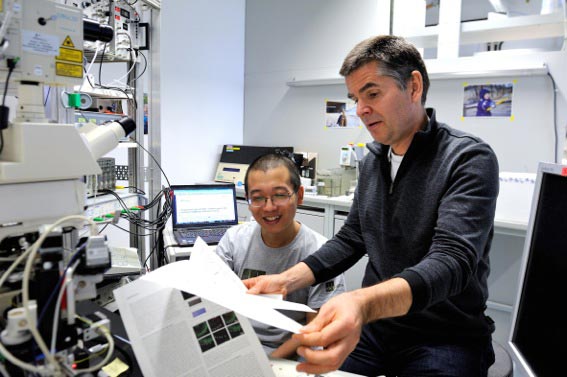March 23, 2014
Jonas: third major publication since December
Neuroscientist Peter Jonas continues streak with paper on signaling mechanisms in brain cells • Publication deals with central aspect of his ERC grant • Research explains how basket cells achieve reliability and speed in signal transmission

In his third major research paper since December 2013, IST Austria Professor Peter Jonas together with his collaborator, postdoc Hua Hu, identifies a new subcellular mechanism for reliable, fast transmission in the so-called basket cells of the brain. The results will be published on the website of Nature Neuroscience on March 23, 2014 (DOI 10.1038/nn.3678)
IST Austria president Thomas Henzinger expressed his delight: “This is an extraordinary streak of publications in major journals which once more emphasizes the outstanding work of Peter Jonas and his group. I congratulate Peter on these papers and the institute on enabling its scientists to perform such remarkable achievements.”
Jonas’ Science paper from February 7, 2014, reported the first evidence for “microdomain” coupling at a mature central synapse and explores the implications for synaptic plasticity, and his Neuron paper, published December 12, 2013, dealt with synaptic mechanisms of rhythmic brain waves in vivo. His most recent paper focuses on a key aspect of Jonas’ ERC grant on the “Nanophysiology of fast-spiking, parvalbumin-expressing GABAergic interneurons”. With Jonas’ research group performing cutting-edge research in the field of cellular neuroscience one major focus is on the functional analysis of GABAergic interneurons.
GABAergic interneurons, or basket cells, play a key role in information processing in neuronal networks in the hippocampus. To fulfill their function, signal transmission has to be both fast and reliable: basket cells convert an incoming excitatory signal into an outgoing inhibitory signal within up to a millisecond, and this output signal needs to be distributed to a large number of target cells. Two major mechanisms are generally thought to allow signals to travel quickly and reliably: a large axon diameter and a coating of the axonal surface with myelin, a lipid membrane that allows the electric impulse to ‘hop’ between breaks in the coating. As their axons are thin and branch extensively, large axon diameter cannot be at work in basket cells. Furthermore, myelination cannot be involved, because a high density of sites of synaptic transmission, so called en-passant boutons, prevents the formation of myelin coverage. The researchers therefore asked how, in the face of these hurdles, basket cells are able to transmit signals quickly and reliably. In their paper, Peter Jonas and Hua Hu identify a new subcellular mechanism for reliable, fast transmission – a controlled increase in the density of Na+ channels and conductance in axons of basket cells.
Through sub-cellular patch-clamp recordings, the researchers show that action potentials, the nerve impulses, are initiated close to the cell body and then travel highly reliably along the axon. Interestingly, basket cell axons show a stepwise increase in Na+ channel density and accompanying conductance from the cell body to the proximal axon, where action potentials are initiated. Furthermore, channel density and conductance increase gradually along the rest of the axon. Na+ channels in the axon are also more rapidly inactivated than channels in the cell body, which may increase the energy efficiency of action potential propagation in the axon. Based on these findings, Jonas and Hu develop a cable model of basket cells, showing that a low Na+ channel density is enough for reliable action potential propagation, but the observed high channel density is necessary for the speed of propagation. The researchers test their prediction using tetrodotoxin, a toxin that blocks Na+ channels. When they apply tetrodotoxin to basket cells, signals are still transmitted reliably, but significantly more slowly. Also, the frequency of action potential generation is reduced when Na+ channels are blocked. Axonal Na+ channel density therefore affects both reliability and speed of signal transmission, and also the characteristic high frequency firing in basket cells.
Hu and Jonas show that basket cells compensate for their small axon diameter and lack of myelination by a high density of Na+ channels and a thereby increased conductance, which enable basket cells to achieve reliability and speed in signal transmission. The researchers therefore identify a new mechanism for reliable fast signaling in vertebrate neurons, which has previously only been described in invertebrates.



